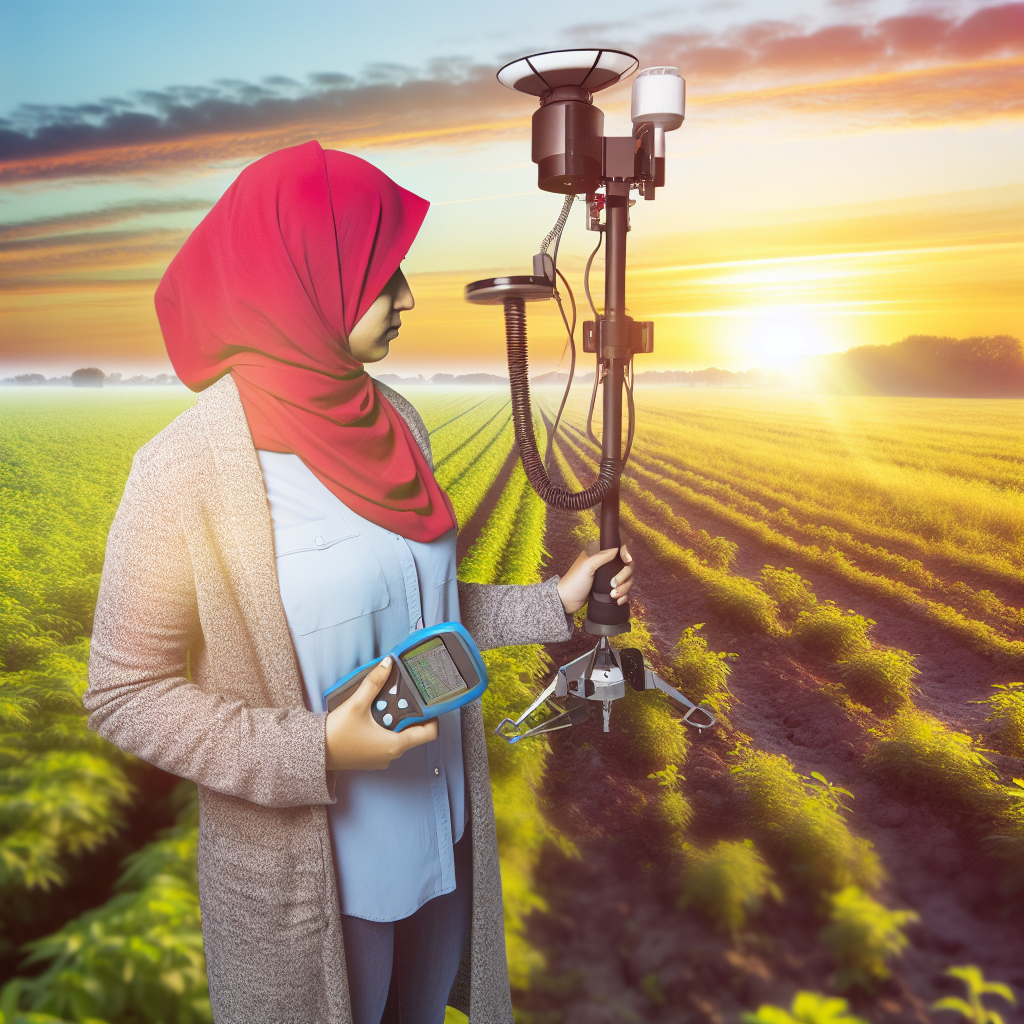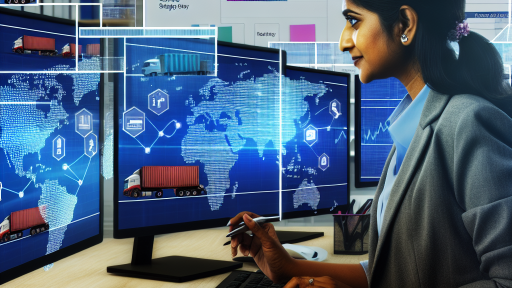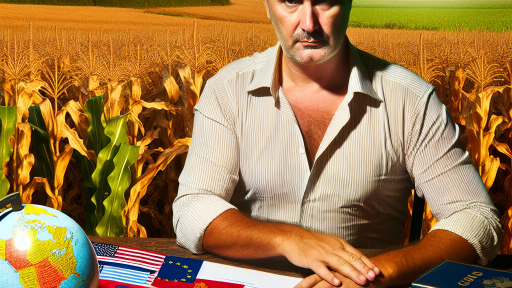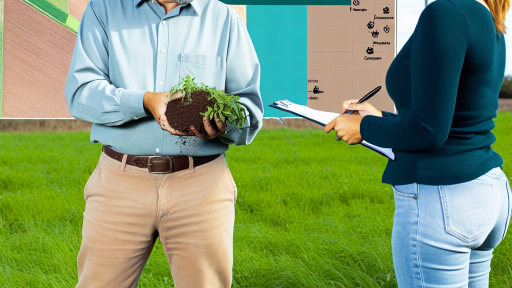Introduction to Remote Sensing in Agriculture
Remote sensing technology plays a vital role in modern agriculture.
This technology provides valuable data for farmers seeking sustainable practices.
With satellite imagery and aerial drones, farmers can monitor their crops effectively.
Moreover, these tools help assess soil health and moisture levels accurately.
As a result, farmers can make informed decisions about resource management.
Understanding Remote Sensing Technology
Remote sensing involves collecting data from a distance without direct contact.
This method uses satellite or aerial imagery to gather information.
Various sensors capture data on crop health, temperature, and moisture.
Additionally, it allows farmers to detect diseases and pest infestations early.
Benefits of Remote Sensing in Agriculture
Remote sensing enhances precision agriculture significantly.
This technology optimizes the use of water, fertilizers, and pesticides.
Consequently, farmers can minimize waste and reduce costs.
Moreover, it improves crop yield and quality through timely interventions.
Applications of Remote Sensing Tools
Farmers utilize remote sensing for various applications.
- Monitoring plant health and growth trends.
- Assessing water needs and irrigation strategies.
- Analyzing soil conditions to enhance fertility.
- Tracking crop yields during different growth stages.
These applications promote sustainable farming by maximizing productivity.
Transform Your Agribusiness
Unlock your farm's potential with expert advice tailored to your needs. Get actionable steps that drive real results.
Get StartedThe Future of Remote Sensing in Sustainable Farming
As technology advances, remote sensing will continue to evolve.
Farmers will gain access to more precise and real-time data.
This shift will empower farmers to adopt innovative practices.
Ultimately, remote sensing will play a pivotal role in sustainable agriculture.
Overview of Remote Sensing Tools
Introduction to Remote Sensing
Remote sensing plays a crucial role in modern agriculture.
It enables farmers to monitor and manage their crops effectively.
Additionally, these tools assist in making informed decisions.
Types of Remote Sensing Tools
There are two main categories of remote sensing technologies.
These include satellite remote sensing and aerial remote sensing.
Both methods have unique applications and advantages.
Satellite Remote Sensing
Satellite remote sensing utilizes orbiting satellites.
These satellites capture images of the Earth’s surface.
Farmers use them to analyze large agricultural areas.
Some examples include Landsat and Sentinel satellites.
Aerial Remote Sensing
Aerial remote sensing often employs drones or aircraft.
This method provides high-resolution images of fields.
Farmers can collect data at specific times and locations.
Companies like PrecisionHawk offer advanced aerial solutions.
Technologies Used in Remote Sensing
Several technologies underpin remote sensing tools.
These include multispectral imaging and LiDAR technology.
Multispectral Imaging
Multispectral imaging captures data across various wavelengths.
This technology helps in assessing plant health and growth.
Farmers can monitor crop stress and optimize resources.
LiDAR Technology
LiDAR stands for Light Detection and Ranging.
Showcase Your Farming Business
Publish your professional farming services profile on our blog for a one-time fee of $200 and reach a dedicated audience of farmers and agribusiness owners.
Publish Your ProfileThis technology measures distances using laser pulses.
It creates detailed 3D maps of terrain and vegetation.
LiDAR helps farmers understand land topography better.
Benefits of Using Remote Sensing Tools
Remote sensing tools improve decision-making in agriculture.
They enhance productivity while minimizing environmental impacts.
Farmers can optimize water usage and fertilizer application.
This approach contributes to sustainable farming practices.
Benefits of Remote Sensing for Sustainable Farming Practices
Enhancing Crop Monitoring
Remote sensing tools improve crop monitoring efficiency significantly.
Farmers can access real-time data about their fields.
This data helps in early detection of crop stress and disease.
Furthermore, it allows for precise irrigation and fertilization practices.
Optimizing Resource Management
Remote sensing contributes to better resource management in farming.
Farmers can analyze soil moisture levels accurately.
This information guides irrigation schedules to conserve water.
Additionally, crop health assessments improve nutrient application.
Reducing Environmental Impact
Utilizing remote sensing decreases the environmental impact of farming.
Farmers can apply inputs like fertilizers and pesticides more judiciously.
This reduces chemical runoff into surrounding ecosystems.
Consequently, it helps maintain healthier soil and water systems.
Supporting Sustainable Practices
Remote sensing technology supports various sustainable farming practices.
It aids in precision agriculture techniques that enhance yields.
This method minimizes the carbon footprint of traditional farming.
Moreover, it fosters greater biodiversity in agricultural systems.
Market and Economic Insights
Remote sensing offers valuable market insights for farmers.
Data analytics can identify trends in crop performance.
Farmers adjust their planting strategies based on these insights.
This proactive approach enhances profitability and reduces waste.
You Might Also Like: Social Media Marketing for Agribusiness Success
Applications of Remote Sensing in Crop Health Monitoring
Introduction to Remote Sensing
Remote sensing provides critical information about crop health.
This technology uses satellite imagery and aerial data.
Farmers can monitor large areas more efficiently than ever.
Moreover, it helps detect issues before they spread.
Identifying Crop Stress
Remote sensing can identify various types of crop stress.
For instance, it detects water stress due to inadequate irrigation.
Additionally, the technology can identify nutrient deficiencies.
Farmers receive timely alerts to take corrective measures.
Early Detection of Pests and Diseases
Effective monitoring aids early detection of pests and diseases.
Remote sensing captures changes in plant health over time.
These changes often indicate the presence of harmful organisms.
Consequently, farmers can implement pest control interventions.
Showcase Your Farming Business
Publish your professional farming services profile on our blog for a one-time fee of $200 and reach a dedicated audience of farmers and agribusiness owners.
Publish Your ProfileYield Prediction and Assessment
Yield predictions benefit significantly from remote sensing.
Farmers utilize satellite data to estimate crop yields accurately.
This information aids in planning and resource distribution.
Additionally, it assists in market analysis and pricing strategies.
Precision Agriculture Techniques
Remote sensing supports precision agriculture techniques.
This approach optimizes inputs such as water, fertilizers, and pesticides.
Farmers apply resources where they are most needed.
The result is increased efficiency and minimized waste.
Monitoring Soil Conditions
Soil health is crucial for sustainable farming practices.
Remote sensing allows farmers to monitor soil moisture levels.
It also helps assess soil quality and fertility.
This information guides effective crop planning and management.
Benefits of Remote Sensing Technologies
Remote sensing technologies reduce the dependency on traditional practices.
They empower farmers with valuable data for decision-making.
As a result, crop health monitoring becomes more effective.
This innovation paves the way for sustainable farming practices.
Discover More: Building Successful Partnerships In Agriculture Today
Using Remote Sensing for Precision Agriculture
Introduction to Remote Sensing
Remote sensing provides vital data for precision agriculture.
This technique helps farmers monitor and manage their fields efficiently.
It utilizes satellite imagery, drones, and sensors to gather information.
Benefits of Remote Sensing
Remote sensing enhances decision-making in farming operations.
It allows for precise application of water, fertilizers, and pesticides.
This practice reduces waste and increases crop yield significantly.
Farmers can identify plant health issues early and act quickly.
Common Remote Sensing Tools
Several tools enable effective remote sensing in agriculture.
- Satellite Imagery: It offers a broad overview of large areas.
- Drones: These devices capture detailed images at varying heights.
- Ground Sensors: They provide real-time data on soil conditions.
Satellite Imagery for Agriculture
Satellite imagery helps in monitoring crop growth and health.
High-resolution images provide insights into vegetation indices.
This data assists in assessing water stress and nutrient levels.
Drones and Their Applications
Drones are becoming increasingly popular in modern agriculture.
They can cover fields quickly and capture high-resolution imagery.
Additionally, drones facilitate targeted crop spraying and mapping.
Ground Sensors Importance
Ground sensors provide critical information about soil moisture.
This data helps farmers optimize irrigation strategies.
Moreover, these sensors can monitor pH levels and nutrient content.
Integrating Remote Sensing with Other Technologies
Integrating remote sensing with GPS technologies enhances accuracy.
This combination allows for precise field mapping and application.
Furthermore, it supports data sharing among farmers and agronomists.
Combining Remote Sensing with IoT
The Internet of Things (IoT) brings connectivity to remote sensing.
Smart sensors can transmit real-time data for immediate response.
This integration improves resource management and sustainability.
Showcase Your Farming Business
Publish your professional farming services profile on our blog for a one-time fee of $200 and reach a dedicated audience of farmers and agribusiness owners.
Publish Your ProfileChallenges and Considerations
While remote sensing offers numerous benefits, challenges exist.
Technical expertise is necessary for effective implementation.
Moreover, initial costs for equipment can be significant.
Addressing Technical Challenges
Farmers may require training to use remote sensing tools effectively.
Access to technical support is also crucial for success.
Financial Considerations
Investment in technology can be daunting for some farmers.
However, the long-term benefits often outweigh initial costs.
Find Out More: Creating a Legacy with Farm Succession Planning

Impact of Remote Sensing on Soil Health Assessment and Management
Understanding Remote Sensing Technology
Remote sensing technology captures data from a distance.
This technology uses satellites or drones to monitor agricultural land.
The data collected is crucial for analyzing soil health.
Farmers use this information to make informed decisions.
Benefits of Remote Sensing for Soil Health
Remote sensing offers significant advantages for soil management.
It provides real-time data about soil conditions.
This data improves understanding of moisture levels.
Farmers can quickly assess nutrient levels in their soil.
Furthermore, it helps in identifying soil erosion areas.
Methods of Soil Health Assessment
Different methods enhance the assessment of soil health.
One method involves analyzing imagery for vegetation cover.
Another method uses hyperspectral imaging for soil analysis.
This imagery helps determine soil organic matter content.
Using reflectance data, farmers can monitor soil health changes.
Remote Sensing in Precision Agriculture
Remote sensing plays a vital role in precision agriculture.
It allows farmers to apply resources effectively.
Farmers can optimize water usage through targeted irrigation.
They can also apply fertilizers and pesticides more efficiently.
This precision leads to healthier crops and reduced waste.
Case Studies and Applications
Several case studies illustrate the effectiveness of remote sensing.
For instance, the Green Seekers project used drones for soil analysis.
This project helped farmers enhance crop yields significantly.
Additionally, the SoilGrids initiative provides global soil information.
Farmers worldwide utilize this data for better decision-making.
Future Trends in Remote Sensing for Agriculture
The future of remote sensing in agriculture looks promising.
Advancements in technology will improve accuracy and efficiency.
New satellite systems will provide higher resolution imagery.
Moreover, artificial intelligence will enhance data analysis.
Farmers will increasingly rely on remote sensing for sustainable practices.
Explore Further: Health Insurance Options for Farming Families
Integrating Remote Sensing Data with GIS for Enhanced Decision Making
Understanding Remote Sensing Technology
Remote sensing technology captures data from a distance.
It uses aerial platforms such as satellites and drones.
Showcase Your Farming Business
Publish your professional farming services profile on our blog for a one-time fee of $200 and reach a dedicated audience of farmers and agribusiness owners.
Publish Your ProfileThis technology collects vital information about agricultural land.
Farmers can monitor crop health and soil conditions remotely.
The Role of Geographic Information Systems (GIS)
Geographic Information Systems integrate spatial data effectively.
GIS helps visualize geographic relationships and patterns.
Farmers can analyze various data types, including soil and weather data.
This analysis enhances decision-making in farming operations.
Benefits of Integrating Remote Sensing with GIS
The integration of remote sensing and GIS offers significant advantages.
Farmers can obtain detailed insights into land use and crop performance.
This data aids in precision agriculture practices.
Additionally, farmers can optimize resource allocation efficiently.
Improved Crop Management
Farmers can observe crop growth patterns over time.
This monitoring helps identify areas needing attention.
Through targeted interventions, yields can increase significantly.
Efficient Resource Usage
Integrating data helps farmers manage water and fertilizers better.
This reduces wastage and lowers production costs.
As a result, sustainable practices become easier to implement.
Case Studies of Successful Implementation
Several farms have successfully integrated remote sensing and GIS.
Green Fields Organic Farm utilized this approach to enhance productivity.
The farm observed a remarkable increase in yield through targeted irrigation.
Similar success stories can inspire other farmers to adopt these technologies.
Challenges in Integration
Despite the benefits, challenges exist in integrating these technologies.
Data accuracy and management can pose significant hurdles.
Investing in training is essential for efficient technology use.
Additionally, initial setup costs can be a barrier for some farmers.
Future Trends in Remote Sensing and GIS
The future for integrating these technologies looks promising.
Advancements in drone technology will enhance data collection.
Moreover, machine learning algorithms can improve data analysis.
As a result, decision-making will become increasingly data-driven.
Case Studies: Successful Implementation of Remote Sensing in Sustainable Farming
Precision Agriculture in Practice
Agricultural innovations implemented remote sensing to optimize resource use.
This technology helped farmers monitor crop health effectively.
For instance, GreenField Farms utilized drones to assess soil moisture levels.
They synchronized irrigation schedules based on real-time data.
This led to a noticeable reduction in water waste.
Consequently, crop yields improved significantly.
Monitoring Environmental Impact
Twin Rivers Organic Farm adopted satellite imagery to track land use changes.
This approach enhanced their decision-making in crop rotation practices.
Moreover, they identified areas of nutrient depletion swiftly.
As a result, they improved soil health over time.
Using remote sensing reduced the need for chemical fertilizers.
Pest and Disease Management
Maplewood Ranch implemented remote sensing for pest detection.
Showcase Your Farming Business
Publish your professional farming services profile on our blog for a one-time fee of $200 and reach a dedicated audience of farmers and agribusiness owners.
Publish Your ProfileThey used thermal imaging to identify hotspots of infestation.
This method allowed for targeted pesticide application.
As a result, they minimized chemical usage significantly.
The farm reported healthier plants and increased biodiversity.
Climate Adaptation Strategies
Sunny Acres Farm integrated remote sensing to enhance climate resilience.
They analyzed weather patterns to adjust planting schedules.
This proactive approach reduced crop losses due to extreme events.
Furthermore, it supported better planning for seasonal variations.
Ultimately, farmers experienced greater economic stability.
Community Engagement and Education
Harvest Together Co-op created workshops on remote sensing technology.
They educated local farmers on the benefits of data-driven agriculture.
This initiative increased community awareness and collaboration.
Ultimately, it empowered farmers to adopt sustainable practices.
The co-op reported higher member satisfaction and productivity levels.
Additional Resources
Application of digital technologies for ensuring agricultural productivity




